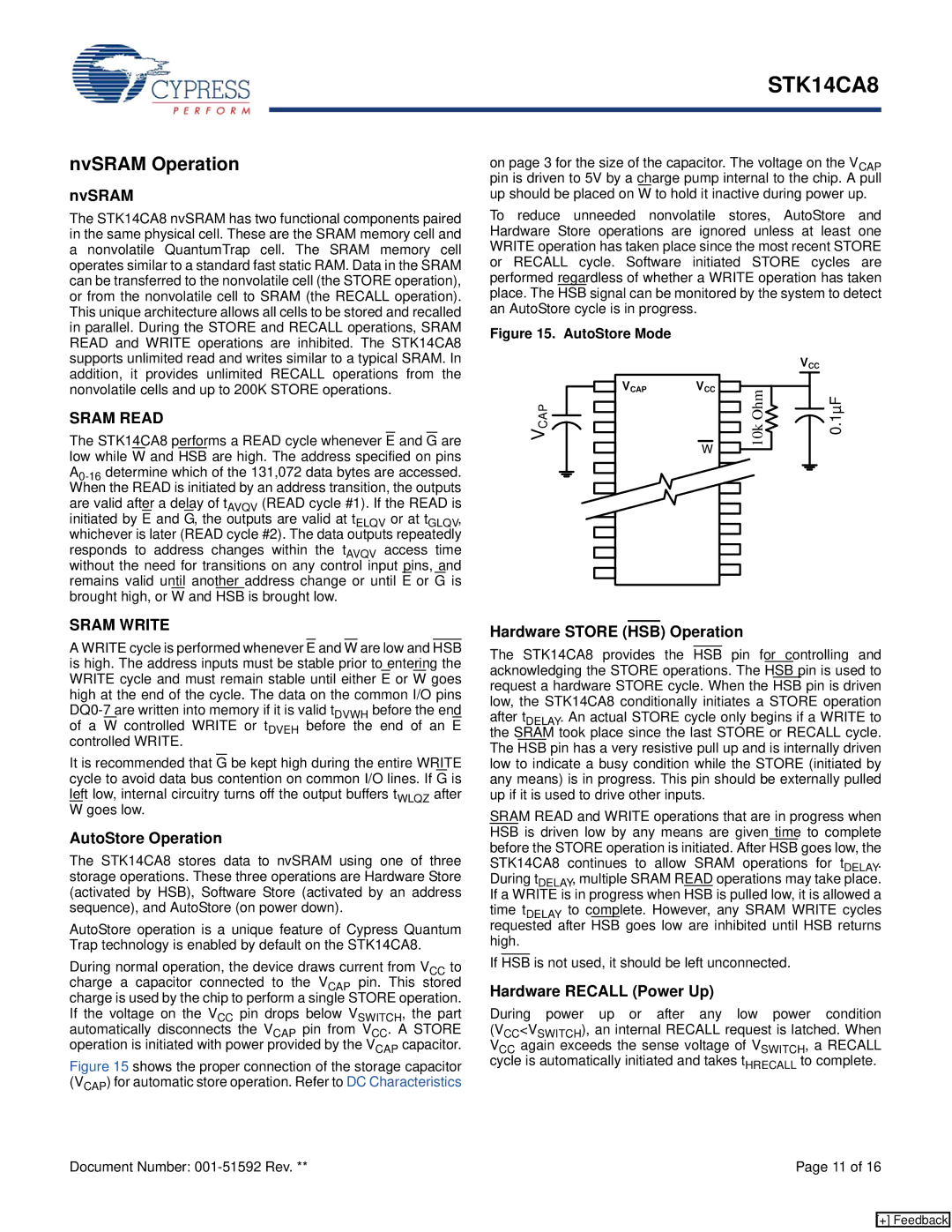
STK14CA8
nvSRAM Operation
nvSRAM
The STK14CA8 nvSRAM has two functional components paired in the same physical cell. These are the SRAM memory cell and a nonvolatile QuantumTrap cell. The SRAM memory cell operates similar to a standard fast static RAM. Data in the SRAM can be transferred to the nonvolatile cell (the STORE operation), or from the nonvolatile cell to SRAM (the RECALL operation). This unique architecture allows all cells to be stored and recalled
on page 3 for the size of the capacitor. The voltage on the VCAP pin is driven to 5V by a charge pump internal to the chip. A pull up should be placed on W to hold it inactive during power up.
To reduce unneeded nonvolatile stores, AutoStore and Hardware Store operations are ignored unless at least one WRITE operation has taken place since the most recent STORE or RECALL cycle. Software initiated STORE cycles are performed regardless of whether a WRITE operation has taken place. The HSB signal can be monitored by the system to detect an AutoStore cycle is in progress.
in parallel. During the STORE and RECALL operations, SRAM READ and WRITE operations are inhibited. The STK14CA8 supports unlimited read and writes similar to a typical SRAM. In addition, it provides unlimited RECALL operations from the nonvolatile cells and up to 200K STORE operations.
SRAM READ
The STK14CA8 performs a READ cycle whenever E and G are low while W and HSB are high. The address specified on pins
Figure 15. AutoStore Mode
VCAP
CAP
V
VCC
W
![]() 10k Ohm
10k Ohm![]()
VCC ![]() 0.1µF
0.1µF
SRAM WRITE
A WRITE cycle is performed whenever E and W are low and HSB is high. The address inputs must be stable prior to entering the WRITE cycle and must remain stable until either E or W goes high at the end of the cycle. The data on the common I/O pins
It is recommended that G be kept high during the entire WRITE cycle to avoid data bus contention on common I/O lines. If G is left low, internal circuitry turns off the output buffers tWLQZ after W goes low.
AutoStore Operation
The STK14CA8 stores data to nvSRAM using one of three storage operations. These three operations are Hardware Store (activated by HSB), Software Store (activated by an address sequence), and AutoStore (on power down).
AutoStore operation is a unique feature of Cypress Quantum Trap technology is enabled by default on the STK14CA8.
During normal operation, the device draws current from VCC to charge a capacitor connected to the VCAP pin. This stored charge is used by the chip to perform a single STORE operation. If the voltage on the VCC pin drops below VSWITCH, the part automatically disconnects the VCAP pin from VCC. A STORE operation is initiated with power provided by the VCAP capacitor.
Figure 15 shows the proper connection of the storage capacitor (VCAP) for automatic store operation. Refer to DC Characteristics
Document Number:
Hardware STORE (HSB) Operation
The STK14CA8 provides the HSB pin for controlling and acknowledging the STORE operations. The HSB pin is used to request a hardware STORE cycle. When the HSB pin is driven low, the STK14CA8 conditionally initiates a STORE operation after tDELAY. An actual STORE cycle only begins if a WRITE to the SRAM took place since the last STORE or RECALL cycle. The HSB pin has a very resistive pull up and is internally driven low to indicate a busy condition while the STORE (initiated by any means) is in progress. This pin should be externally pulled up if it is used to drive other inputs.
SRAM READ and WRITE operations that are in progress when HSB is driven low by any means are given time to complete before the STORE operation is initiated. After HSB goes low, the STK14CA8 continues to allow SRAM operations for tDELAY. During tDELAY, multiple SRAM READ operations may take place. If a WRITE is in progress when HSB is pulled low, it is allowed a time tDELAY to complete. However, any SRAM WRITE cycles requested after HSB goes low are inhibited until HSB returns high.
If HSB is not used, it should be left unconnected.
Hardware RECALL (Power Up)
During power up or after any low power condition (VCC<VSWITCH), an internal RECALL request is latched. When VCC again exceeds the sense voltage of VSWITCH, a RECALL cycle is automatically initiated and takes tHRECALL to complete.
Page 11 of 16
[+] Feedback
